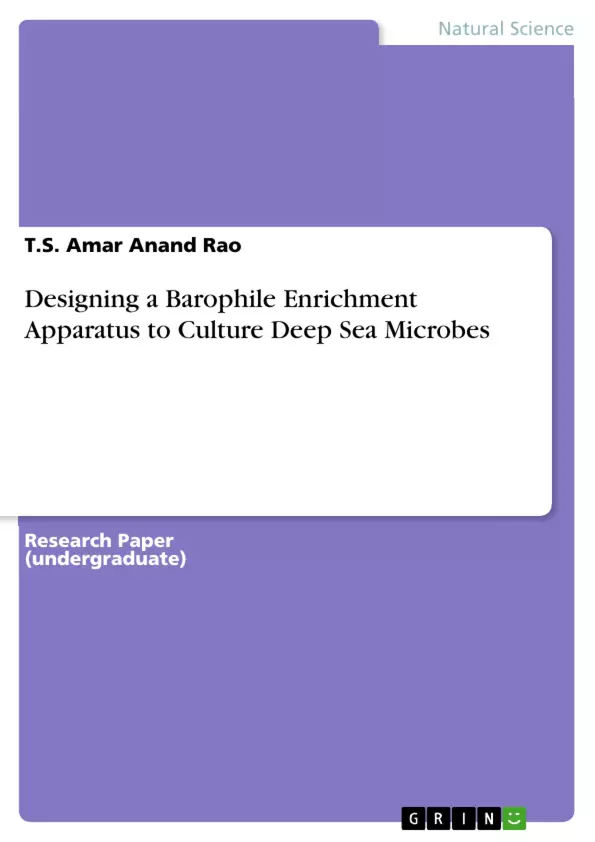Ever since the days of Holger W. Jannasch, the great deep sea microbiologist, the culturing and isolation of barophiles have come to existence. But using high pressure chemostat facilities are hard and high priced. We discuss a simple lab make barophile enrichment apparatus to culture and study deep sea microbes. We also isolate deep sea microbes that corrodes iron from sunken ships.
Table of Contents
- Abstract
- Introduction
- History of Barophiles and Pressure Research
- Materials and Methods
Objectives and Key Themes
The objective of this work is to describe a simple, laboratory-made apparatus for enriching and culturing barophilic deep-sea microbes. The apparatus utilizes a modified Winogradsky column design to achieve pressures exceeding atmospheric pressure. The study also aims to isolate deep-sea microbes capable of corroding iron.
- Design and construction of a low-cost barophile enrichment apparatus.
- Culturing and studying deep-sea microbes using the designed apparatus.
- Isolation of iron-corroding deep-sea microbes.
- Exploration of the history and significance of barophile research.
- Application of existing high-pressure culturing techniques in a simplified context.
Chapter Summaries
Abstract: This chapter provides a concise overview of the research, highlighting the challenges in culturing barophiles and introducing the development of a simplified, cost-effective enrichment apparatus for deep-sea microbial cultures, focusing on iron-corroding species.
Introduction: This chapter establishes the context for studying deep-sea microbes, emphasizing the complexity of deep-sea ecosystems and the need for innovative culturing techniques. It introduces the Winogradsky column as a foundational model and discusses the limitations of existing high-pressure chemostat systems, motivating the development of a more accessible alternative.
History of Barophiles and Pressure Research: This section delves into the historical context of barophile research, tracing its evolution from early observations to the development of sophisticated high-pressure culturing methods. It highlights key figures like Holger W. Jannasch and discusses the importance of understanding the interplay between pressure, temperature, and microbial life. The chapter explores the development of pressure measurement technology, emphasizing the role of barometers and their significance in studying high-pressure environments.
Materials and Methods: This chapter details the procedure for constructing the modified Winogradsky column, emphasizing the use of readily available materials and simple techniques. It describes the apparatus's components, including one-way valves, a pressure gauge (barometer), and an iron rod for enriching corrosive microbes. The chapter provides a step-by-step guide for creating a pressure differential within the system and maintaining constant pressure, ensuring reproducibility and accessibility.
Keywords
Barophile, deep-sea microbes, enrichment culture, Winogradsky column, high-pressure, corrosion, iron, one-way valve, barometer, chemostat.
Frequently Asked Questions: A Comprehensive Language Preview
What is the purpose of this research?
The main objective is to describe a simple, inexpensive apparatus for enriching and culturing barophilic (pressure-loving) deep-sea microbes, particularly those capable of corroding iron. This involves adapting a modified Winogradsky column design to achieve pressures exceeding atmospheric pressure.
What are the key themes explored in this research?
Key themes include the design and construction of a low-cost barophile enrichment apparatus; culturing and studying deep-sea microbes using this apparatus; isolating iron-corroding deep-sea microbes; exploring the history and significance of barophile research; and applying existing high-pressure culturing techniques in a simplified context.
What is the significance of the Winogradsky column in this research?
The Winogradsky column serves as a foundational model, providing a relatively simple and adaptable system for creating a suitable environment for cultivating barophilic microbes under pressure. The research modifies this design to create a more accessible and cost-effective alternative to existing, more complex high-pressure chemostat systems.
What are the key components of the designed apparatus?
The apparatus, a modified Winogradsky column, includes readily available components such as one-way valves, a pressure gauge (barometer), and an iron rod to facilitate the enrichment of iron-corroding microbes. The design emphasizes simplicity and ease of construction.
What is discussed in the chapter on the "History of Barophiles and Pressure Research"?
This chapter traces the evolution of barophile research, highlighting key figures and advancements in high-pressure culturing methods. It also emphasizes the development of pressure measurement technology and its importance in studying high-pressure environments.
How is pressure controlled and maintained in the apparatus?
The "Materials and Methods" chapter provides a step-by-step guide for creating and maintaining a pressure differential within the modified Winogradsky column, ensuring reproducibility and accessibility of the method. Specific details on achieving and maintaining constant pressure are included.
What are the key challenges addressed by this research?
The research directly addresses the challenges of culturing barophiles, which are difficult to study due to the demanding high-pressure conditions of their natural habitats. The focus is on developing a simplified, cost-effective method to overcome these challenges.
What are the key words associated with this research?
Key words include: Barophile, deep-sea microbes, enrichment culture, Winogradsky column, high-pressure, corrosion, iron, one-way valve, barometer, chemostat.
What is included in the abstract?
The abstract provides a concise overview of the research, focusing on the challenges of culturing barophiles and the development of a simplified, cost-effective enrichment apparatus for deep-sea microbial cultures, with a particular emphasis on iron-corroding species.
What is the introduction's purpose?
The introduction establishes the context for studying deep-sea microbes, highlighting the complexity of deep-sea ecosystems and the need for innovative culturing techniques. It introduces the Winogradsky column as a foundational model and discusses limitations of existing high-pressure chemostat systems, motivating the development of a more accessible alternative.
- Citar trabajo
- T.S. Amar Anand Rao (Autor), 2011, Designing a Barophile Enrichment Apparatus to Culture Deep Sea Microbes, Múnich, GRIN Verlag, https://www.grin.com/document/184271



